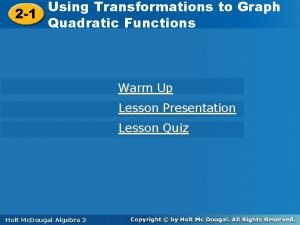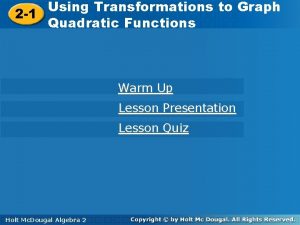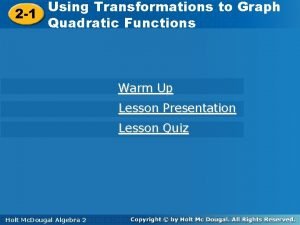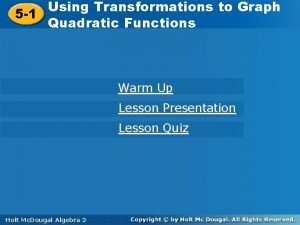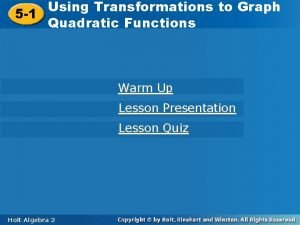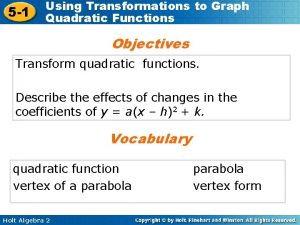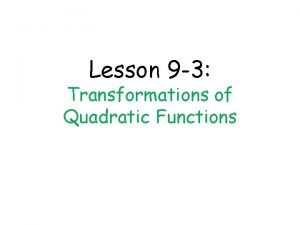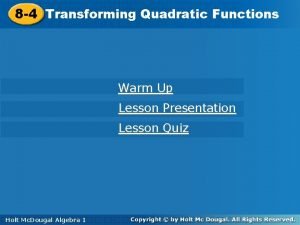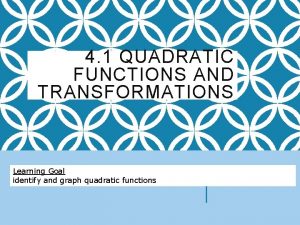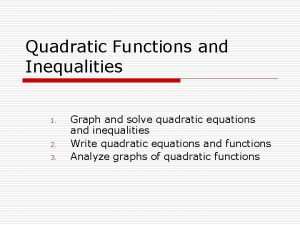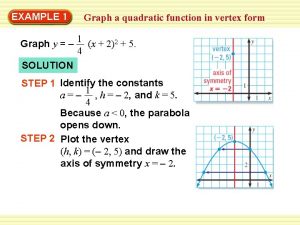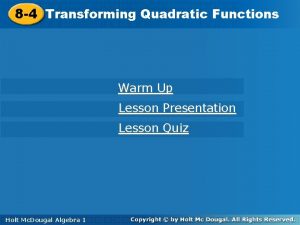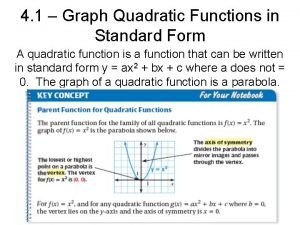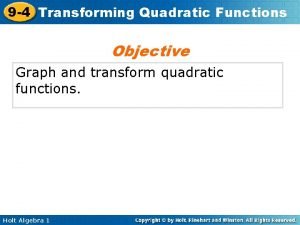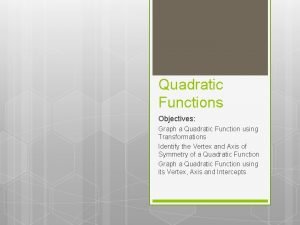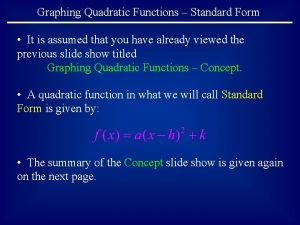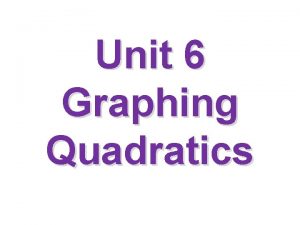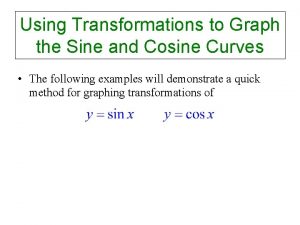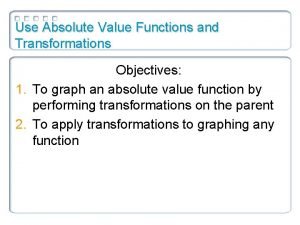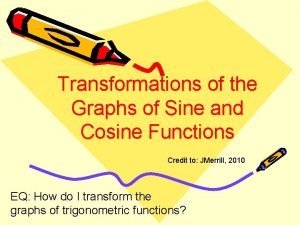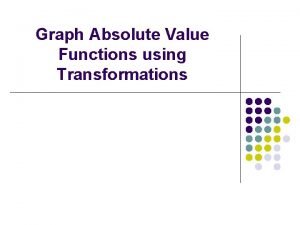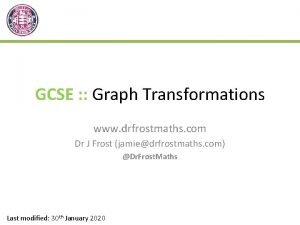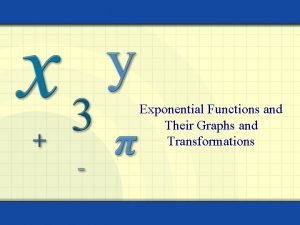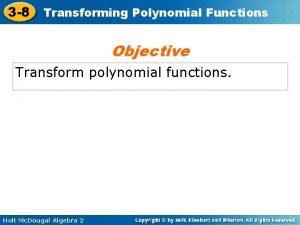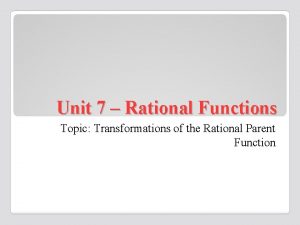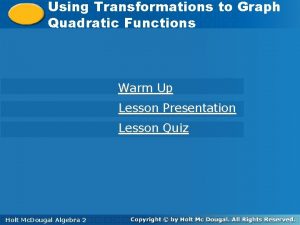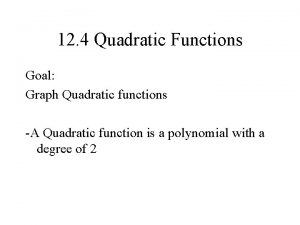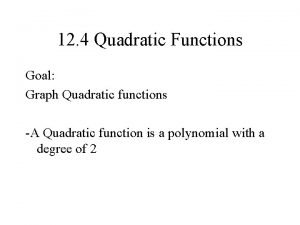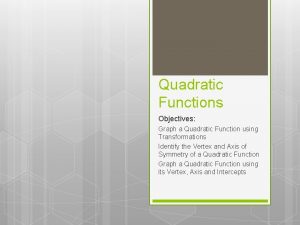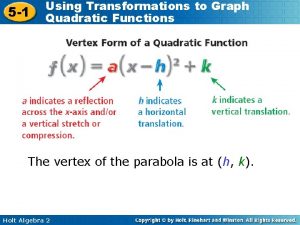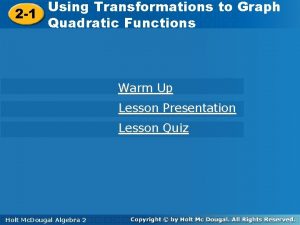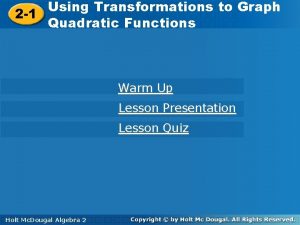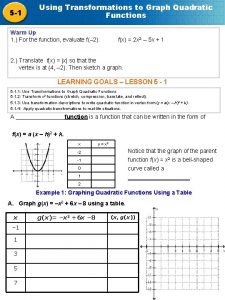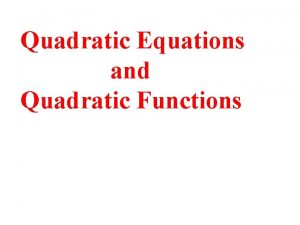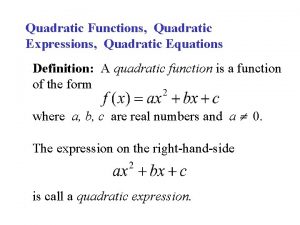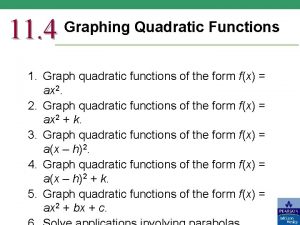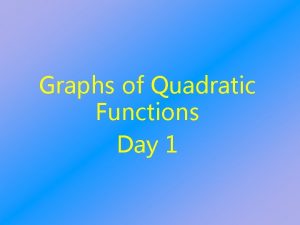2 1 Using Transformations to Graph Quadratic Functions






























- Slides: 30

2 -1 Using Transformations to Graph Quadratic Functions Objectives Transform quadratic functions. Describe how changes in the values of a, h, and k affect the graph of the function y = a(x – h)2 + k. Holt Mc. Dougal Algebra 2

2 -1 Using Transformations to Graph Quadratic Functions Vocabulary quadratic function parabola vertex of a parabola vertex form Holt Mc. Dougal Algebra 2

2 -1 Using Transformations to Graph Quadratic Functions In prior classes you studied linear functions of the form f(x) = mx + b. A quadratic function is a function that can be written in the form of f(x) = a (x – h)2 + k (a ≠ 0). In a quadratic function, the variable is always squared. The table shows the linear and quadratic parent functions. Holt Mc. Dougal Algebra 2

2 -1 Using Transformations to Graph Quadratic Functions Notice that the graph of the parent function f(x) = x 2 is a U-shaped curve called a parabola. As with other functions, you can graph a quadratic function by plotting points with coordinates that make the equation true. Holt Mc. Dougal Algebra 2

2 -1 Using Transformations to Graph Quadratic Functions Example 1: Graphing Quadratic Functions Using a Table Graph f(x) = x 2 – 4 x + 3 by using a table. Make a table. Plot enough ordered pairs to see both sides of the curve. x f(x)= x 2 – 4 x + 3 (x, f(x)) 0 f(0)= (0)2 – 4(0) + 3 (0, 3) 1 2 f(1)= (1)2 – 4(1) + 3 f(2)= (2)2 – 4(2) + 3 (1, 0) (2, – 1) 3 f(3)= (3)2 – 4(3) + 3 (3, 0) 4 f(4)= (4)2 – 4(4) + 3 (4, 3) Holt Mc. Dougal Algebra 2

2 -1 Using Transformations to Graph Quadratic Functions Example 1 Continued f(x) = x 2 – 4 x + 3 • • • Holt Mc. Dougal Algebra 2 • •

2 -1 Using Transformations to Graph Quadratic Functions Exploration Time!!!! Holt Mc. Dougal Algebra 2

2 -1 Using Transformations to Graph Quadratic Functions You can also graph quadratic functions by applying transformations to the parent function f(x) = x 2. Transforming quadratic functions is similar to transforming linear functions (Lesson 2 -6). Holt Mc. Dougal Algebra 2

2 -1 Using Transformations to Graph Quadratic Functions Example 2 A: Translating Quadratic Functions Use the graph of f(x) = x 2 as a guide, describe the transformations and then graph each function. g(x) = (x – 2)2 + 4 Identify h and k. g(x) = (x – 2)2 + 4 h k Because h = 2, the graph is translated 2 units right. Because k = 4, the graph is translated 4 units up. Therefore, g is f translated 2 units right and 4 units up. Holt Mc. Dougal Algebra 2

2 -1 Using Transformations to Graph Quadratic Functions Check It Out! Example 2 a Using the graph of f(x) = x 2 as a guide, describe the transformations and then graph each function. g(x) = x 2 – 5 Identify h and k. g(x) = x 2 – 5 k Because h = 0, the graph is not translated horizontally. Because k = – 5, the graph is translated 5 units down. Therefore, g is f is translated 5 units down. Holt Mc. Dougal Algebra 2

2 -1 Using Transformations to Graph Quadratic Functions Check It Out! Example 2 b Use the graph of f(x) =x 2 as a guide, describe the transformations and then graph each function. g(x) = (x + 3)2 – 2 Identify h and k. g(x) = (x – (– 3)) 2 + (– 2) h k Because h = – 3, the graph is translated 3 units left. Because k = – 2, the graph is translated 2 units down. Therefore, g is f translated 3 units left and 2 units down. Holt Mc. Dougal Algebra 2

2 -1 Using Transformations to Graph Quadratic Functions Recall that functions can also be reflected, stretched, or compressed. Holt Mc. Dougal Algebra 2

2 -1 Using Transformations to Graph Quadratic Functions Holt Mc. Dougal Algebra 2

2 -1 Using Transformations to Graph Quadratic Functions Example 3 A: Reflecting, Stretching, and Compressing Quadratic Functions Using the graph of f(x) = x 2 as a guide, describe the transformations and then graph each function. g (x ) =- 1 x 4 2 Because a is negative, g is a reflection of f across the x-axis. Because |a| = , g is a vertical compression of f by a factor of. Holt Mc. Dougal Algebra 2

2 -1 Using Transformations to Graph Quadratic Functions Example 3 B: Reflecting, Stretching, and Compressing Quadratic Functions Using the graph of f(x) = x 2 as a guide, describe the transformations and then graph each function. g(x) =(3 x)2 Because b = , g is a horizontal compression of f by a factor of. Holt Mc. Dougal Algebra 2

2 -1 Using Transformations to Graph Quadratic Functions Check It Out! Example 3 a Using the graph of f(x) = x 2 as a guide, describe the transformations and then graph each function. g(x) =(2 x)2 Because b = , g is a horizontal compression of f by a factor of. Holt Mc. Dougal Algebra 2

2 -1 Using Transformations to Graph Quadratic Functions Check It Out! Example 3 b Using the graph of f(x) = x 2 as a guide, describe the transformations and then graph each function. g(x) = – x 2 Because a is negative, g is a reflection of f across the x-axis. Because |a| = , g is a vertical compression of f by a factor of. Holt Mc. Dougal Algebra 2

2 -1 Using Transformations to Graph Quadratic Functions If a parabola opens upward, it has a lowest point. If a parabola opens downward, it has a highest point. This lowest or highest point is the vertex of the parabola. The parent function f(x) = x 2 has its vertex at the origin. You can identify the vertex of other quadratic functions by analyzing the function in vertex form. The vertex form of a quadratic function is f(x) = a(x – h)2 + k, where a, h, and k are constants. Holt Mc. Dougal Algebra 2

2 -1 Using Transformations to Graph Quadratic Functions Because the vertex is translated h horizontal units and k vertical from the origin, the vertex of the parabola is at (h, k). Helpful Hint When the quadratic parent function f(x) = x 2 is written in vertex form, y = a(x – h)2 + k, a = 1, h = 0, and k = 0. Holt Mc. Dougal Algebra 2

2 -1 Using Transformations to Graph Quadratic Functions Example 4: Writing Transformed Quadratic Functions Use the description to write the quadratic function in vertex form. The parent function f(x) = x 2 is vertically stretched by a factor of and then translated 2 units left and 5 units down to create g. Step 1 Identify how each transformation affects the constant in vertex form. Vertical stretch by 4 4 = a : 3 3 Translation 2 units left: h = – 2 Translation 5 units down: k = – 5 Holt Mc. Dougal Algebra 2

2 -1 Using Transformations to Graph Quadratic Functions Example 4: Writing Transformed Quadratic Functions Step 2 Write the transformed function. g(x) = a(x – h)2 + k Vertex form of a quadratic function = (x – (– 2))2 + (– 5) Substitute = (x + 2)2 – 5 g(x) = (x + 2)2 – 5 Holt Mc. Dougal Algebra 2 Simplify. for a, – 2 for h, and – 5 for k

2 -1 Check Using Transformations to Graph Quadratic Functions Graph both functions on a graphing calculator. Enter f as Y 1, and g as Y 2. The graph indicates the identified transformations. f g Holt Mc. Dougal Algebra 2

2 -1 Using Transformations to Graph Quadratic Functions Check It Out! Example 4 a Use the description to write the quadratic function in vertex form. The parent function f(x) = x 2 is vertically compressed by a factor of and then translated 2 units right and 4 units down to create g. Step 1 Identify how each transformation affects the constant in vertex form. Vertical compression by : a= Translation 2 units right: h = 2 Translation 4 units down: k = – 4 Holt Mc. Dougal Algebra 2

2 -1 Using Transformations to Graph Quadratic Functions Check It Out! Example 4 a Continued Step 2 Write the transformed function. g(x) = a(x – h)2 + k Vertex form of a quadratic function = (x – 2)2 + (– 4) Substitute = (x – 2)2 – 4 g(x) = (x – 2)2 – 4 Holt Mc. Dougal Algebra 2 Simplify. for a, 2 for h, and – 4 for k.

2 -1 Using Transformations to Graph Quadratic Functions Check It Out! Example 4 a Continued Check Graph both functions on a graphing calculator. Enter f as Y 1, and g as Y 2. The graph indicates the identified transformations. f g Holt Mc. Dougal Algebra 2

2 -1 Using Transformations to Graph Quadratic Functions Intercept Form Equation y=a(x-p)(x-q) • • The x-intercepts are the points (p, 0) and (q, 0). The axis of symmetry is the vertical line x= The x-coordinate of the vertex is To find the y-coordinate of the vertex, plug the xcoord. into the equation and solve for y. • If a is positive, parabola opens up If a is negative, parabola opens down. Holt Mc. Dougal Algebra 2

2 -1 Using Transformations to Graph Quadratic Functions Example 3: Graph y=-(x+2)(x-4) • Since a is negative, parabola opens down. • The x-intercepts are (-2, 0) and (4, 0) • To find the x-coord. of the vertex, use • The axis of symmetry is the vertical line x=1 (from the xcoord. of the vertex) (1, 9) • To find the y-coord. , plug 1 in for x. (-2, 0) (4, 0) • Vertex (1, 9) x=1 Holt Mc. Dougal Algebra 2

2 -1 Using Transformations to Graph Quadratic Functions Now you try one! y=2(x-3)(x+1) • Open up or down? • X-intercepts? • Vertex? • Axis of symmetry? Holt Mc. Dougal Algebra 2

2 -1 Using Transformations to Graph Quadratic Functions x=1 (3, 0) (-1, 0) (1, -8) Holt Mc. Dougal Algebra 2

2 -1 Using Transformations to Graph Quadratic Functions Challenge Problem • Write the equation of the graph in vertex form. Holt Mc. Dougal Algebra 2
 How to graph quadratic functions using transformations
How to graph quadratic functions using transformations Using transformations to graph quadratic functions
Using transformations to graph quadratic functions Using transformations to graph quadratic functions
Using transformations to graph quadratic functions Using transformations to graph quadratic functions
Using transformations to graph quadratic functions Using transformations to graph quadratic functions
Using transformations to graph quadratic functions Using transformations to graph quadratic functions
Using transformations to graph quadratic functions Dilations of quadratic functions
Dilations of quadratic functions Transformation of quadratic functions calculator
Transformation of quadratic functions calculator 4-1 quadratic functions and transformations
4-1 quadratic functions and transformations Bb.4 transformations of quadratic functions
Bb.4 transformations of quadratic functions Tangent and cotangent graph
Tangent and cotangent graph How to find the vertex of a parabola in quadratic form
How to find the vertex of a parabola in quadratic form Which of the quadratic functions has the narrowest graph?
Which of the quadratic functions has the narrowest graph? Graph quadratic functions in standard form
Graph quadratic functions in standard form Which of the quadratic functions has the narrowest graph
Which of the quadratic functions has the narrowest graph How to know if a graph opens up or down
How to know if a graph opens up or down How to graph quadratic functions in standard form
How to graph quadratic functions in standard form Intercept form of a quadratic function
Intercept form of a quadratic function Quadratic transformations rules
Quadratic transformations rules Sine and cosine graphs
Sine and cosine graphs Absolute value functions and transformations
Absolute value functions and transformations Cosine graph transformations
Cosine graph transformations Graph transformations
Graph transformations Translating graphs worksheet
Translating graphs worksheet Absolute value transformation
Absolute value transformation Drfrostmaths
Drfrostmaths Graphing exponential functions calculator
Graphing exponential functions calculator Transforming polynomial functions
Transforming polynomial functions Transforming rational functions
Transforming rational functions Function graph transformations
Function graph transformations Vertical stretch logarithmic function
Vertical stretch logarithmic function
